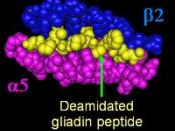Gluten Intolerance Or Celiac Disease
Gluten is a mixture of proteins present in the cereal grains. The long molecules of gluten insoluble in water are strong and flexible and form many cross linkages. This gives flour its characteristic chewiness and permits breads and cakes to rise during baking as the gases within expand and are trapped in the gluten superstructure. Various flours have different ratios of gluten to starch called hardness and are appropriate for different types of food. Thus soft flour is used for cakes, harder flour for pastry, hard flour for bread and hardest or durum for pasta.
Gluten Intolerance or Celiac disease is a digestive disease that damages the small intestine and interferes with absorption of nutrients from food. People who have celiac disease can not tolerate a protein called gluten that is found in wheat, rye and barley. Gluten is found in mainly in foods but is also found in products we use every day such as stamp and envelope adhesive, medicines and vitamins.
When people with celiac disease eat food or use products containing gluten, their immune system responds by damaging the small intestine. The tiny fingerlike protrusions lining the small intestine called villi are damaged or destroyed. Villi allow nutrients from food to be absorbed into bloodstream. Therefore, without healthy villi, a person becomes malnourished, regardless of the quantity of food eaten. However, it is also classified as a disease of malabsorption because nutrients are not absorbed. Celiac is also known as celiac sprue, nontropical sprue and gluten sensitive enteropathy. Celiac disease is a genetic disease so meaning it runs in families. Sometimes the disease is triggered or becomes active for the first time after surgery, pregnancy, childbirth, viral infection, or several emotion stresses.
Celiac disease affects people differently. Symptoms may occur in the...


